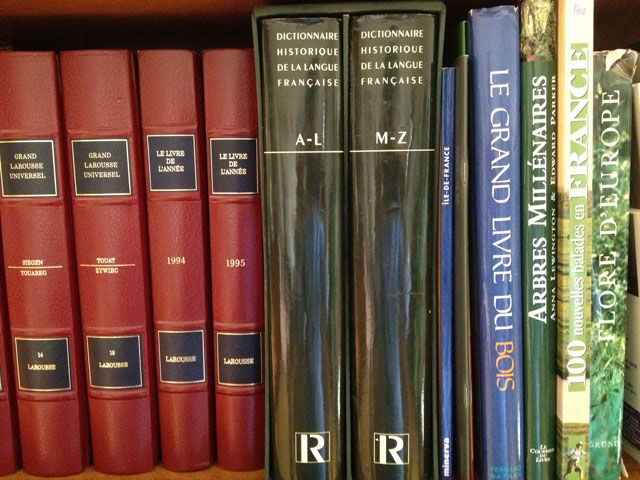A post by Susan from Days on the Claise in which she described the fare offered at her local charcuterie set me thinking about the word “persillé” which literally means “parsleyed”, used to describe pâté or brawn with parsley through it.
However, when applied to an entrecôté or côte de boeuf, it also means “marbled”, that is, with streaks of fat through it. I couldn’t quite understand how, etymologically, you could get from parsley in a pâté to streaks of fat in meat.
So I checked out my very favourite dictionary, the “Dictionnaire Historique de la Langue Française”, a beautiful two-volume affair that has that lovely thin bible paper. I happened upon it once at the Maison du Dictionnaire in Paris when I was looking for some technical dictionaries and, despite its exorbitant price, couldn’t resist buying it. But I’ve never regretted it.
“Persillé” was first recorded in 1694 with its original meaning of blue or rather green-veined cheese, “not to be confused with persillé meaning a preparation with parsley as a condiment”, a rather strange thing to say as you would imagine that the resemblance to parsley would have come first.
By analogy with the green-veined cheese, it means anything “with green stains” (1864). There’s a cheese called “persillé de Savoie“. But it has another unexpected meaning. In Provençal, “persil” (parsley) is slang for “money”, along with “oseille” (sorrel) and “épinards” (spinach), and, by analogy (once again), for prostitution (1840). As a result, “persiller” also means “to sollicit clients” no less.
So now you can go off to the butcher’s and ask for an “entrecôte bien persillée” (unfortunately the way I prefer it) and to the cheesemongers and surprise them by ordering “fromage persillé“.






Friday’s French – persillé http://t.co/qL5ZUOTUKE
My understanding is that the parsley brawn uses the word persillé in both its senses, so it is a bit of a word play. I think it is too much of a coincidence that the second meaning originally meant the bluey green speckles of penicillin in the cheese — surely that is because it is as if it had chopped parsley incorporated. Or did the herb get it’s name because when you chop it and incorporate it in dishes it looks like the penicillin in cheese?
Yes, I agree. The bluey-green speckles triggered the use of the term “persillé” because they looked like parsely used in cooking and it was by analogy to the blue veins that the meat is called “persillé”, which is why I was surprised they should say “not to be confused with persillé meaning a preparation with parsely as a condiment”. But they were talking about the word itself having a different meaning. It comes out sounding a little confused and I seem to have made it even more confusing! As you say, the brawn is both “persillé” streaked and “persillé” with parlsey.